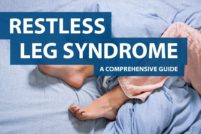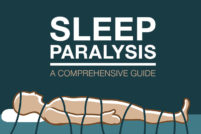We often accept our snoring (or our partner’s snoring) as simply an irksome habit. However, in many cases snoring is actually a symptom of a potentially dangerous underlying disorder: sleep apnea.
The effects of sleep apnea reach far beyond restless nights, and there is growing evidence that — left untreated — this disorder has a significant negative impact on your overall health.
If you suspect that you or a loved one is suffering from sleep apnea, get the facts and learn what steps to take to get treatment.
What Is Sleep Apnea?
Sleep apnea is a common sleep disorder that makes you to experience repeated pauses in your breathing, or extremely shallow breathing while you’re asleep.
Over the course of a night, someone with sleep apnea can experience as many as 30 of these breathing episodes per hour. The episodes are often followed by a loud snort or choking sound, after which your breathing returns to normal.
The 3 Types Of Sleep Apnea
Cases of sleep apnea can be divided into three categories based on what is the source of your nighttime breathing trouble.
Obstructive sleep apnea
Obstructive sleep apnea is the most common form of this disorder and is caused by excessive relaxation of the throat muscles.The muscles in the back of your throat are responsible for supporting the surrounding soft tissues (like your uvula, tonsils and walls of your throat).
When they relax too much they can cause these soft tissues to fall inwards, narrowing your airway and making it difficult to catch your breath.
Central sleep apnea
Central sleep apnea is more rare and is due to a disorder in communication between the brain and the muscles which control breathing.
Unlike in obstructive sleep apnea, people with central sleep apnea do not struggle to breathe but rather have periods wherein their body simply stops breathing entirely.
Complex sleep apnea
Complex sleep apnea is the term used when someone suffers from both obstructive and central sleep apnea simultaneously. This form of the disorder is the trickiest to treat.It can be difficult to determine what type of sleep apnea you are suffering from; but discovering the source is absolutely essential to properly treat the disorder.

Symptoms Of Sleep Apnea
Whether you have obstructive or central sleep apnea the symptoms you experience will be very similar.Some of the symptoms listed here are secondary — meaning that they arise as a result of the sleep disruption caused by the primary symptoms. You can learn more about the negative effects of sleep deprivation here.
Common Symptoms Of Sleep Apnea:
- Snoring: Very loud snoring is often the most apparent sign you may have sleep apnea, and is more often associated with the obstructive type.
- Pauses in breathing: These episodes of breath arrestation often go unnoticed by the sufferer themselves and instead require a witness to draw them to your attention.
- Sudden awakening: A pause in breathing may cause you to wake up suddenly. If you awaken feeling short of breath you are more likely to be suffering from central sleep apnea.
- Dry mouth or sore throat: The combination of snoring and gasping for breath associated with sleep apnea can dry out your mouth and throat.
- Headache: Breathing troubles may also cause you to wake up in the morning with a throbbing headache due to high levels of carbon dioxide in your blood.
- Insomnia: Similar to experiencing sudden awakenings, some sleep apnea sufferers may experience difficulty staying asleep, and falling back to sleep.
- Hypersomnia: Since sleep apnea affects the quality of your sleep, you may experience excessive daytime sleepiness.
- Attention & memory problems: A lack of sleep is known to negatively impact your ability to concentrate and retain new information.
- Changes in mood: Sleep deprivation as a result of sleep apnea can have a significant effect on your mood: causing irritability, anxiety and even depression.
Risk Factors For Sleep Apnea
Certain factors put you at a greater risk for developing sleep apnea. While some of these factors are unavoidable (you can’t turn back your age), others can be dealt with by making lifestyle changes (such as dieting to lose weight).
Risk Factors For Obstructive Sleep Apnea
- Male
- Age 40+
- Overweight
- Large neck circumference (17” or more for men, 16”or more for women)
- Large tonsils or tongue
- Small jaw bone
- Family history of sleep apnea
- Gastroesophageal reflux (GERD)
- Nasal obstruction (deviated septum, allergies, or sinus problems)
Risk Factors For Central Sleep Apnea
- Male
- Age 65+
- Heart disorders (atrial fibrillation, congestive heart failure)
- Stroke, brain tumor, brainstem lesion
- High altitude
- Opioid use
- CPAP machine use
Some people develop central sleep apnea when first using continuous positive airway pressure (CPAP) machine to treat their obstructive sleep apnea. This is the leading cause of complex sleep apnea and often goes away with continued CPAP use.
Health Impact Of Sleep Apnea
Aside from the obvious negative impact on your ability to get a good night’s rest, if left untreated, sleep apnea may increase your risk of developing certain chronic health problems.

Source: www.richmondinstitute.com
- High blood pressure
- Heart attack
- Irregular heartbeat
- Heart failure
- Stroke
- Obesity
- Diabetes
- Depression
- Chronic headaches
Additionally, being chronically sleep deprived can increase your chances of being involved in a work-related or driving accident.
For these reasons it’s extremely important to talk to your doctor if you suspect you may be suffering from sleep apnea. While the impact on your daily activities may seem small at first, the long term consequences are not worth delaying treatment.
Diagnosing Sleep Apnea
Signs It’s Time To See Your Doctor
If you’re experiencing any of the following four symptoms on a recurring basis then you should make it a priority to visit your doctor:
- Snoring so loud that you wake those around you.
- Waking up suddenly with shortness of breath, gasping or choking.
- Pauses in your breathing while asleep (observed by a witness)
- Falling asleep during normal daytime activities.
These are clear signals that something is wrong with your sleep — whether it be sleep apnea or another sleep disorder or medical condition. Tackling your sleep problems early on can help you avoid sleep debt.
What To Expect From Your Doctor’s Visit
If you’ve decided it’s a good idea to have your symptoms checked by your doctor, here’s what you can expect from your visit.
To make the most out of your time with your doctor, it’s a great idea to come prepared with a list of any medications you take and answers to some basic questions that may help determine your diagnosis.
What to expect from a Physical Exam?
Your doctor will perform a basic physical exam, and may run some basic lab tests to check for any underlying conditions or infections that may be to blame for your symptoms.
Questions your doctor might ask
Your doctor will then ask you question to gain a better understanding of your symptoms, which will guide them in diagnosing you.
- How long have you been experiencing your symptoms?
- Are your symptoms continuous, or do they come and go?
- How severe are your symptoms?
- Do you stop breathing during sleep?
- If yes, how many times a night?
- Does anything help your symptoms?
- Does anything make symptoms worse? (sleep position, alcohol consumption)
Which tests you should expect
Depending on your symptoms, your doctor may decide to refer you to a sleep specialist for further testing to see exactly what is going on while you sleep. These tests can also help your doctor determine whether your sleep apnea is obstructive or central.
Nocturnal Polysomnography: This is a very comprehensive sleep test conducted at a specialized lab. While you sleep a variety of equipment will monitor the activity of your heart, lungs and brain; as well as keep track of your breathing patterns, oxygen levels, and the movements of your limbs.
Home Sleep Tests: While an in-lab polysomnography is the gold standard of sleep apnea diagnosis, It’s not always necessary to spend a night at a sleep lab: your doctor can send you home with a device to measure your oxygen level, heart rate, airflow and breathing patterns.
What Will These Tests Show?
These tests generate a large amount of data, which is used to calculate specific parameters which offer insight into your sleep disorder. Objective measures that you may find differ significantly from your self-reported. For instance, many people with sleep apnea greatly overestimate the amount of sleep they are getting each night.
- Total Sleep Time
- Sleep Efficiency & Latency
- Sleep Cycles
- Awakenings/Arousals
- Breathing Patterns
Most importantly for a diagnosis of sleep apnea, your apnea-hypopnea index (AHI) will be calculated. Your AHI is the number of apneas and/or hypopneas you experience per hour as you sleep.
Apnea: A complete cessation of breathing, lasting 10 seconds or longer.
Hypopnea: A constricted breath which lasts 10 seconds or longer.
This value will not only tell your doctor if you are suffering from sleep apnea, but can also determine the severity of your condition.
| AHI | 5-15 | 15-30 | 30+ |
|---|---|---|---|
| Sleep Apnea | Mild | Moderate | Severe |
Treating Sleep Apnea – Home Remedies & Medical Treatments
What You Can Do
Some cases of sleep apnea may resolve themselves if you make certain lifestyle changes. Even if they do not completely eliminate your symptoms, incorporating some of these changes can help you get some relief while awaiting treatment.
- Sleep on your side
- Avoid alcohol 4-6 hours before bedtime
- Limit use of sedative medications
- Lose weight
- Exercise
- Open your sinuses
- Stop smoking
Medical Interventions
Moderate to severe sleep apnea often requires the use of specialized medical devices to improve airflow as you sleep.
Continuous Positive Airway Pressure (CPAP)
CPAP helps relieve sleep apnea by delivering air pressure through a mask placed over your nose, which helps prevent your airway from collapsing.
Getting used to sleeping with CPAP can be difficult at first, but the majority of people are able to adjust by playing with the tension of the straps, or trying alternate styles of mask. If you feel that you’ve tried everything and are still experiencing discomfort, or if you’re still snoring with CPAP on, talk to your doctor. It’s important that you do not stop using CPAP without first consulting a medical professional.
Other Air Pressure Devices
If CPAP continues to cause issues for you, your doctor may suggest using an alternate air pressure device.
- Auto-CPAP: Automatically adjusts air pressure as your are sleeping.
- BiPap: Provide two different levels of air pressure: more when you inhale, and less when you exhale.
- Expiratory Positive Airway Pressure (EPAP): Single use devices that you place over each nostril before going to sleep. They allow air to enter normally on your inhale, but as you exhale the air must pass through a tiny channel, increasing air pressure.
Oral Appliances
Oral appliances can be worn to help keep your airway open; such as by gently bringing the jaw forward, preventing your throat from relaxing.
You can purchase one of these devices from your dentist; and you might have to try a variety before finding the one that works best for you. Once you get the right fit, you’ll have to continue to follow up with your dentist over the course of a year to make sure it’s providing the best relief.
Surgical Options
Surgery should always be kept as a last resort solution. As with any surgical intervention, surgery for sleep apnea comes along with its own risks and side-effects. However, severe sleep apnea can itself be life-threatening, and if other conservative treatments are not effective surgery may be necessary.
- Tissue Removal: During uvulopalatopharyngoplasty some of the soft tissues are removed from the back of the throat. This often includes the tonsils and adenoids.
- Jaw Repositioning: Much like oral appliances, maxillomandibular advancement can be used to permanently move your jaw forward. This makes obstruction less likely to occur by increasing the space behind your tongue.
- Creation Of A New Air Passage: If all other treatments have failed, a tracheostomy creates a secondary air passage in your throat. The tube is kept covered during the day, and is uncovered at night so that air can bypass your throat entirely on its route to your lungs.
Additional Resources
Dealing with sleep apnea on a day to day basis can be challenging but there are tools and support groups that can make your life a bit easier.
ApneaApp
Developed by Washington University, ApneaApp turns your smartphone into an effective sleep study tool. The app uses sonar technology to monitor the movements of your chest and abdomen to determine breathing patterns as you sleep. While not a replacement for polysomnography, ApneaApp has been used in an experimental setting to detect obstructive apnea, central apnea and hypopnea.
SnoreLab
SnoreLab records, measures and tracks your snoring throughout the night. The data is then used to calculate your Snore Score: a measure of the intensity of your snoring problem. You can even playback audio clips. SnoreLab can be a useful tool to bring along with you to your first doctor’s appointment.
Support Groups
Living with sleep apnea comes along with its own set of difficulties and frustrations. Even after receiving your diagnosis, it can take weeks of trial-and-error before you find a treatment that works for you. When times get tough, communicating with people going through the same thing as you can help relieve feelings of isolation.
- A.W.A.K.E: The American Sleep Apnea Association has a mandate to provide patients with access to a wide range of resources, such as publications and informative videos. Additionally, they can put you in touch with a local sleep apnea support group.
- CPAP Talk: One of the largest sleep apnea forums, CPAP Talk has over 40,000 active participants sharing their personal stories, answering questions and providing support to one another. The forum is 100% free to use and is a great place for newly diagnosed people to reach out.





